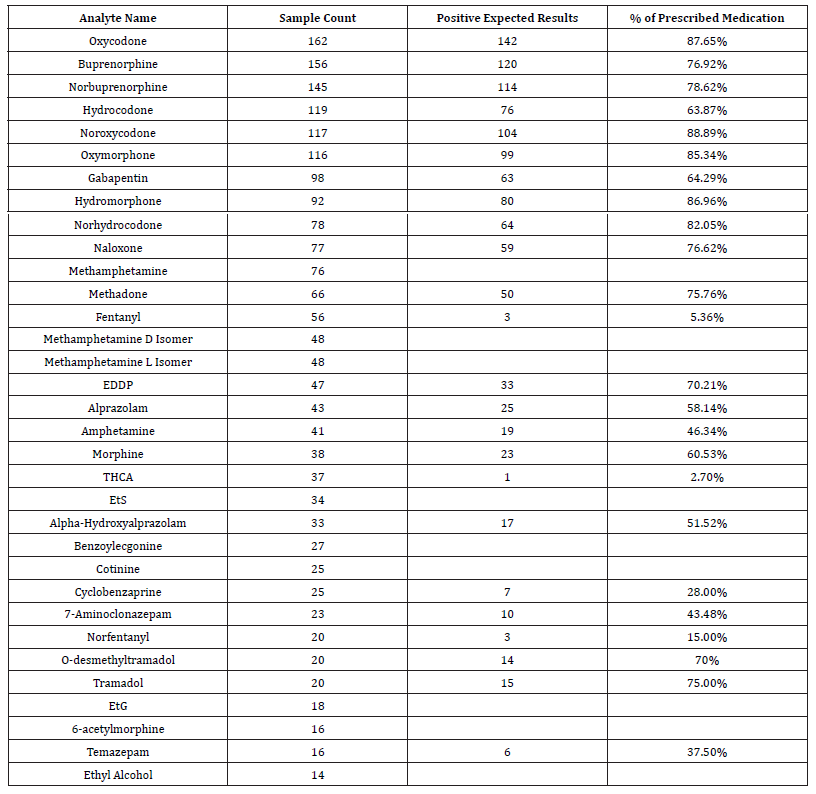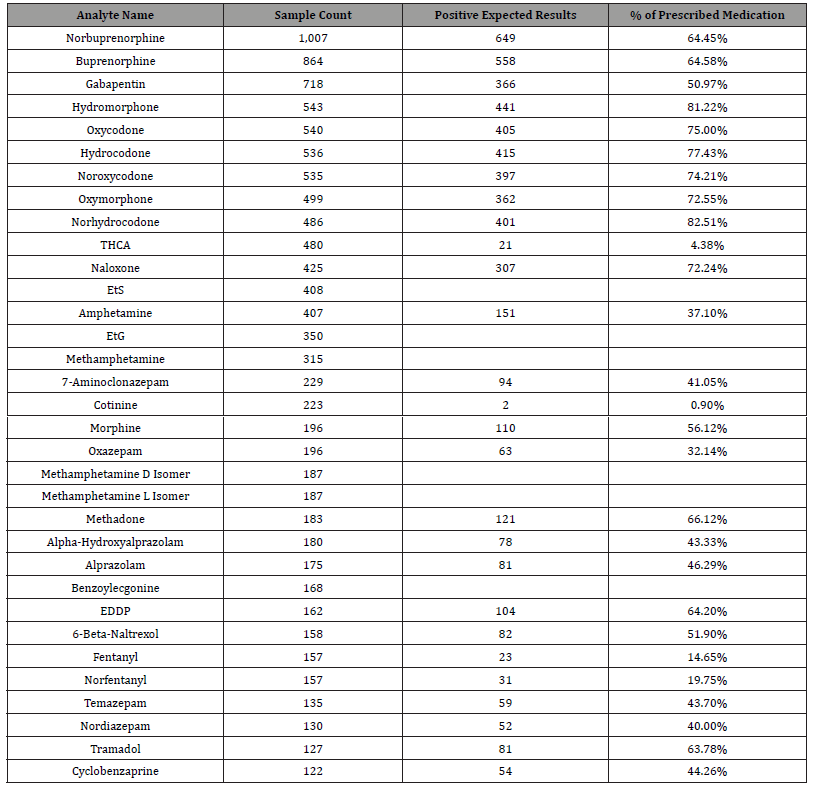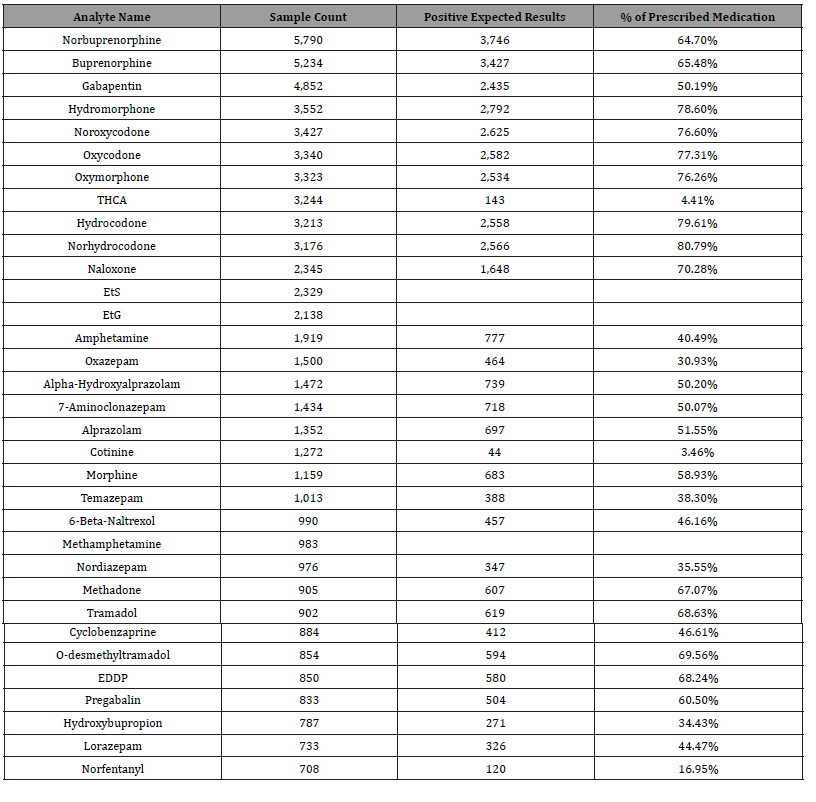 Research Article
Research Article
Observations of Drugs Present in Substituted or Dilute Urine Specimens Using Creatinine Concentrations
Katie Bollman, Keith Tran, Richard Thomas and Amadeo J Pesce*
Precision Diagnostics LLC, San Diego, CA, USA
Amadeo J Pesce, Professor, Precision Diagnostics LLC, 4215, Sorrento Valley Boulevard, San Diego, CA 92121, United States.
Received Date: March 01, 2023; Published Date: March 23, 2023
Abstract
Background: Creatinine is used by drug testing laboratories to determine if the test urine is physiologically appropriate. The Substance Abuse and Mental Health Services Administration (SAMHSA) guidelines define specimens with low creatine concentrations as substituted or dilute. As these specimens might indicate a reason for deception, we decided to monitor them for potential drug presence.
Methods: We partitioned creatinine concentrations from more than one million urine specimens tested for drugs into less than 2mg/dL, 2.01- 10mg/mL and 10.1 to 19.9mg/mL and analyzed them for 80 drugs or their metabolites.
Results: we observed mostly prescription drugs in these specimens. Conclusion. Attempts at deception appear to be directed to hide prescription drug use.
Background
Drug testing is used to monitor subjects for employment, medication compliance, and to check on patients in drug rehabilitation programs. Unfortunately, some individuals being monitored will try to deceive the providers of these tests by altering or substituting the test urines. One method of alteration is by dilution of the urine volume. A second method of alteration is to add an oxidant. Another method of deception is by substituting the test urine with a different one. Two common tests that are used to detect dilution are creatinine concentration and specific gravity. The addition of an oxidant can be detected by chemical testing. The test subject may try to defeat the test by substituting their urine with another product. Some of these substituted urines may not contain physiologic substances such as creatinine.
Creatinine in urine is a by-product of muscle metabolism. The amount observed is a function of muscle mass and is produced at a relatively constant rate. In healthy individual., The range of concentration of the excreted creatinine is from 60 to 300mg/dL. This estimate derives from the NHANES health survey which places the 10th percentile at 57mg/dL and the 90th percentile at 282mg/ dL [1]. As this range of creatinine excretion values describes normal physiology, creatinine can be used to determine if a urine specimen is physiologically valid. That is, the urine creatinine for a valid specimen should be in this range. Creatinine values outside of this range are considered suspect and may not be considered to accurately reflect the true excretion of a test subject’s drug use. In the case of Substance Abuse and Mental Health Services Administration (SAMHSA) sanctioned workplace drug testing, the medical review officer (MRO) must consider that the test urine is a valid specimen. The establishment of a proper test specimen requires that validity testing be done. Specimen validity testing must be performed for each federal agency urine specimen. For urine specimens, at a minimum, creatinine and pH must be determined for each specimen, specific gravity must be determined for each specimen with creatinine less than 20.0 mg/dL, and one or more tests for oxidizing adulterants must be performed [2].
However, the SAMHSA guidelines allow for a more generous definition of the acceptable range of creatinine. The acceptable concentrations should be greater than 20mg/dL. Values less than 2mg/dL are considered substituted urines and those between 2 and 20mg/dL are considered dilute. Over time we have encountered a number of dilute and substituted urines and have tested them for their drug content. We measure an 80-drug panel on all submitted urine specimens including those considered substituted and dilute. Our LC-MS/MS assay is very sensitive and offers the opportunity to detect most of the drugs we monitor at low concentrations [3]. From 2020 to 2022 we measured the drugs on more than 1million submitted urine specimens. We focused on which possible prescription and illicit drugs methamphetamine, heroin (6monoacetylmorphine), cocaine, fentanyl, marijuana that the subjects were taking and trying to hide. We expected to observe a preponderance of illicit drugs in the SAMHSA defined substituted and dilute urines.
Materials and Methods
Specimens were collected from pain management and rehabilitation clinics to monitor compliance [4]. The creatinine was measured using the Thermo-Fisher Jaffe method on the Beckman Coulter analyzer [5]. The measurement range was between 0 and 800mg/dL. The drugs were monitored by the highly sensitive LCMS/ MS method of Krock K, et al. [3]. The data was processed as previously described [6]. The percent positive for each drug was calculated from the drugs listed on the patient request form.
Results
We tabulated the frequency of observed creatinine concentrations in Table 1. Our data parallels that of the NHANES study. That is 80% (805,875) of the creatinine concentrations were between 50 to 300mg/dL with a median of 133mg/dL.
Tables 2-4 are based on 1,057,477 urine specimens collected between 8/10/2020 and 10/31/2022.
Table 1:Creatinine in mg/dL.

Table 2:Drugs observed with creatinine 2 or less 897 observations.

Table 3:Drugs observed from creatinine concentrations 2.01 to 10.0mg/dL 6099 observations.

Table 4:Drugs observed with creatinine concentrations 10.1 to 19.9mg/dL 32260 observations.

These were separated into three tables. The Table 2 shows the results for the 916” substituted” specimens, that is, those with creatinine values less than 2mg/dL Greater than 80% were negative for drugs. Unexpectedly we saw about 20% positive specimens. The most prevalent drugs were oxycodone, buprenorphine and hydrocodone. The most prevalent illicit drugs were methamphetamine and fentanyl. These occurred in less than 9% of the specimens. In this case, the most prevalent drug oxycodone was found to be prescribed in 87% of the cases. Table 3 shows the observations for those dilute specimens in the 2-10mg/ dL range. The most prevalent observed drugs were buprenorphine, gabapentin, and oxycodone. These were observed in less than 20% of the specimens. In these samples, the most prevalent illicit drug was THCA followed by methamphetamine. Table 4 shows the observations on those creatinine specimens in the 10 to 20 mg/dL range. We observed drugs in less than 20% of these cases. The most prevalent drugs were buprenorphine, gabapentin, hydromorphone, and oxycodone. The most prevalent illicit drug was THCA, followed by methamphetamine. However, we noted a considerable number of specimens were positive for the ethanol metabolites.
Discussion
We used creatinine concentrations to estimate attempts at deception of our urine drug tests. Our frequency distribution of creatinine concentrations based upon more than 1million specimens was similar to the NHANES study indicating that our patient population matched those of the NHANES study. It was then possible to define the test population urines with creatinine concentrations outside of this range as substituted or dilute. Our sensitive cutoff for drug detection, allowed us to observe common prescription and illicit drugs. We examined specimens that met the SAMSHA definition of substitution of creatinine concentrations of 2mg/dL or less. As SAMHSA defines these as substituted, In 90% of the cases we did not detect any drugs. We did not expect to observe any drugs, instead we observed 10% or more to be positive for the prescription drugs oxycodone, buprenorphine, and hydrocodone. In this case we were surprised to detect any drugs. Our explanation for those specimens with detectable drugs was that the subject diluted the urine to an extreme degree. In the same manner, we examined those specimens with concentrations of 2-10mg/dL as these specimens are most likely to be intentionally diluted. In this case our findings were positive for buprenorphine, gabapentin, and oxycodone. The most prevalent illicit drugs were THCA followed by methamphetamine. Finally, we looked at the results for those diluted specimens with creatinine concentrations between 10.1 and 19.9mg/dL and we observed the most prevalent drugs were buprenorphine, gabapentin, hydromorphone, and oxycodone. The most prevalent illicit drug was THCA, followed by methamphetamine. However, we noted a significant number of specimens were positive for the ethanol metabolites.
Conclusion
Our finding of mostly prescription drugs in the substituted and dilute specimens is consistent with the hypothesis that attempts for deception are associated with hiding prescription drugs obtained from family and friends.
Acknowledgement
None.
Conflict of Interest
Author declared no conflict of interest.
References
- Barr DB, Wilder LC, Caudill SP, Gonzalez AJ, Needham LL, et al. (2005) Urinary Creatinine Concentrations in the U.S. Population: Implications for Urinary Biologic Monitoring Measurements. Environ Health Perspect 113(2): 192-200.
- Department of Health and Human Services Substance Abuse and Mental Health Services Administration Center for Substance Abuse Prevention. Medical Review Officer Manual.
- Krock K, Pesce A, Ritz D, Thomas R, Cua A, et al. (2017) Cutoff for LC-MS/MS Urine Drug Testing Indicates Better Patient Compliance. Pain Physician 20(7): E1107-1113.
- Amadeo P, Keith T, Richard T, Greg A, Kevin K (2022) Update: Correlation of Fentanyl Positive Drug Screens with other Medications in Patients from Pain, Rehabilitation and Behavioral Programs. Ann Clin Lab Sci 52(5): 825-830.
- Pesce AJ, Chandler N, Ackerman G (2021) Information Technology Structure for Urine Drug Testing Reports. 21st Century Pathol 1(1): 103.
- DRI® Creatinine-Detect® Test Thermo Fisher Microgenics Corporation 46360 Fremont Blvd. Fremont, CA, 94538-6406 USA.






